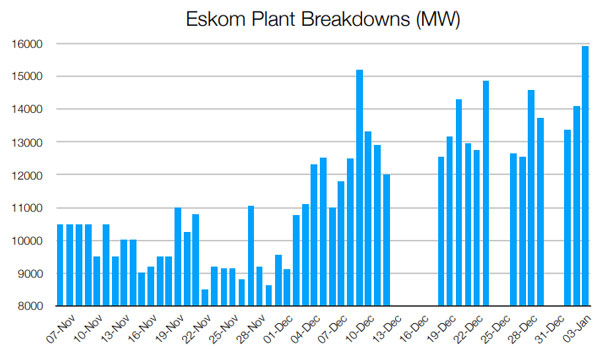
Eskom’s generating plant breakdowns took out a stratospheric 15.9GW on Saturday at 6.30am, the highest level yet, which means an astonishing 40% of its coal fleet of around 40GW was offline.
This is higher than the 15.2GW of outages on Tuesday, 10 December, the day after the utility was hit by a “perfect storm” (flooding power stations, wet coal, broken conveyors at Medupi power station, and very little renewable power being fed into the grid because of the heavy rains), which necessitated stage-6 load shedding.
Since the last instance of load shedding in 2019 (stage 2 on 13 December, with 12GW out of service), Eskom has not made any headway in reducing the alarmingly high level of breakdowns. In fact, the situation has worsened.
Since 19 December (Eskom did not disclose breakdowns for the week prior), the level of unplanned breakdowns across its generating fleet has been above 12.5GW. On five of the 14 days disclosed — it skipped holidays — breakdowns were above 14GW.
Even with lower seasonal demand, it is almost certain that Eskom has been relying on emergency generation resources, including pumped storage schemes and open-cycle gas turbines (OCGTs), to keep the lights on over the holiday period.
While demand dropped significantly from 13 December as mines and factories shut down, the load has remained at around the 26GW level. Using 2018 published data, it is clear that load only drops below 25GW for the week between Christmas Day and New Year’s Day.
Necessary
Eskom said this step was necessary because it had to replenish water levels at its pumped storage schemes and diesel at its OCGTs overnight in preparation for the week ahead. On Sunday morning, however, Eskom said the “loss of additional generation units caused us to have to deplete our diesel and pump storage levels, which we need to restore as we head into the working week on Monday”. It has since repaired the conveyor belt failure at Medupi.
Usefully for Eskom, demand generally ramps up across the next two weeks as mines and factories reopen. Using last year’s data, it is clear that peak load only returns to “normal” summer levels of around 28GW by 15 January. This means it won’t suddenly face “normal” demand today (Monday, 6 January).
In addition, based on performance in December, non-commercial generation (the units at Kusile power station) has been able to add up to 900MW to capacity, which Eskom desperately needs.

Perhaps most importantly, the utility noted on Saturday that Koeberg Unit 1 will return to service in the coming weekend following planned maintenance. Each Koeberg unit provides 930MW of baseload power, which makes this return to service significant. It will take about a week for the unit to ramp up to full generation, which will be helped by the ramp-up in demand.
It added that teams are working flat-out to ensure that the risk of load shedding is minimised as South Africa returns to work.
The utility continues to forecast using the assumption of 9.5GW of unplanned outages, which is completely unrealistic. At this level, it provided a forecast in December of “no shortage” of capacity for the first quarter of the year. However, under its so-called “likely risk scenario” of around 13.7GW of unplanned breakdowns, there are shortages from February.
Worryingly, Eskom decreased the level of planned maintenance in December and January to artificially low levels to keep the lights on. Typically, in the summer months, it should have around 6GW of capacity out of service for planned maintenance. This was the plan until December, when the wheels came off. Instead of doing maintenance on upwards of 6GW of capacity in the week commencing 16 December, it is likely that this figure was far closer to 4GW.
The original plan was to do maintenance on between 5GW and 6.5GW of capacity across January. In the most recent update (pre-Christmas), those peak weeks have been revised down to just over 4GW. This is very bad news for winter: the ageing plants simply become more unreliable as the maintenance backlog increases.
It remains to be seen what a more accurate forecast for the first quarter of 2020 looks like. If breakdown levels remain stubbornly high (above 12GW), load shedding will be the norm until Easter.
We will know by midweek when this data is published.
- This article was originally published on Moneyweb and is used here with permission




